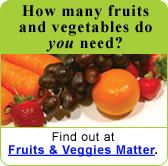Food Groups |
|
Are you interested in healthy eating and having a balanced diet? If so, you'll want to learn more about food groups.
You may have grown up with the "Basic 4": dairy group, meat group, grain group, and the fruits and vegetables group. As nutrition science has changed, so have these food groups.
What are the basic food groups?
Foods are grouped together when they share similar nutritional properties. The groups below are based on the Dietary Approaches to Stop Hypertension (DASH) eating plan. Depending on the plan you choose, you might find the food groups arranged with some slight differences. For example, MyPyramid has a meat and beans group instead of a meat, poultry, and fish group.
| Food Groups | Examples | |
|---|---|---|
| Grains | Whole wheat bread and rolls, whole wheat pasta, English muffin, pita bread, bagel, cereals, grits, oatmeal, brown rice, unsalted pretzels and popcorn |
 |
| Fruits | Apples, apricots, bananas, dates, grapes, oranges, grapefruit, grapefruit juice, mangoes, melons, peaches, pineapples, raisins, strawberries, tangerines, and 100% fruit juice |
 |
| Vegetables | Broccoli, carrots, collards, green beans, green peas, kale, lima beans, potatoes, spinach, squash, sweet potatoes, tomatoes |
 |
| Fat-free or low-fat milk and milk products | Fat-free (skim) or low-fat (1%) milk or buttermilk, fat-free, low-fat, or reduced-fat cheese, fat-free or low-fat regular or frozen yogurt |
 |
| Lean meats, poultry, and fish | Beef, poultry, pork, game meats, fish, shellfish Select only lean; trim away visible fats; broil, roast, or poach; remove skin from poultry |
 |
| Nuts, seeds, and legumes | Almonds, hazelnuts, mixed nuts, peanuts, walnuts, sunflower seeds, peanut butter, kidney beans, lentils, split peas |
 |
How much of each food group should I eat?
To learn this, you'll want to refer to a healthy eating plan. A healthy eating plan will show you how much you need from each food group to stay within your calorie needs and promote good health. A healthy eating plan can also help you learn—
- How many calories you need each day.
- How much of each food equals a portion.
- How to make healthy choices in each food group.
What are some examples of healthy eating plans?
Two examples of healthy eating plans are identified by the Dietary Guidelines for Americans 2005:
 |
MyPyramid.gov (based on The USDA Food Guide) |
 |
The DASH Eating Plan |
Which eating plan should I choose?
Either can work for you. Both are healthy eating plans that—
- Focus on fruits, vegetables, whole grains, and low-fat or fat-free milk and milk products.
- Include lean meats, poultry, fish, beans, eggs, and nuts.
- Are low in saturated fats, trans fats, cholesterol, salt (sodium), and added sugars.
- Can provide your daily calorie needs (when you choose the recommended amounts).
Choose the meal plan that works best for you.
For example, if you want recommendations specific to you, you might choose
MyPyramid.gov by visiting the
My Pyramid Plan
and entering your age, sex, height, weight, and physical activity level.
Here's some more information to help you choose:
| MyPyramid.gov | DASH Eating Plan | |
|---|---|---|
| Where did it come from? |
The United States Department of Agriculture (USDA) Food Guide is the
basis for the eating plans offered through MyPyramid.gov. MyPyramid.gov was developed to help individuals create meal plans specific to their needs and takes into account the following: ·Sex ·Age ·Height ·Weight ·Physical activity level |
DASH stands
for Dietary Approaches to Stop Hypertension. Developed by researchers funded by the National Institutes of Health (NIH) to learn if certain nutrients in foods would help reduce blood pressure. Studies showed that the eating plan, particularly when combined with eating less sodium, lowered blood pressure. Although the plan was developed to help lower blood pressure, it offers a healthy approach to eating that can benefit all adults. |
| What is available to help me? | Tools to develop individualized eating plans, tips for following them, and tools for tracking progress. | Information about food groups, serving sizes, sample menus, and recipes. |
| Where can I go for more information? | See MyPyramid.gov. | See The DASH Eating Plan. |
How do foods with extra fats or sugars fit?
Some foods contain added fats or sugars. Both food plans have categories to help you include these foods in your diet occasionally. The DASH plan has a fats and oils category and a sweets and added sugars category. MyPyramid.gov has an oils category and a discretionary calories category.
![]() Please note: Some of these publications are available for download only as *.pdf files. These files require Adobe Acrobat Reader in order to be viewed. Please review the information on downloading and using Acrobat Reader software.
Please note: Some of these publications are available for download only as *.pdf files. These files require Adobe Acrobat Reader in order to be viewed. Please review the information on downloading and using Acrobat Reader software.
* Links to non-Federal organizations found at this site are provided solely as a service to our users. These links do not constitute an endorsement of these organizations or their programs by CDC or the Federal Government, and none should be inferred. CDC is not responsible for the content of the individual organization Web pages found at these links.
Page last updated: March 6, 2008
Content Source: Division of Nutrition, Physical Activity and Obesity, National Center for Chronic Disease Prevention and Health Promotion


